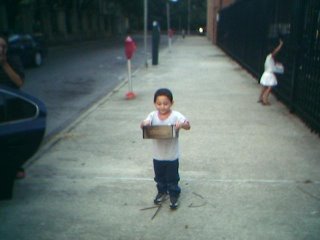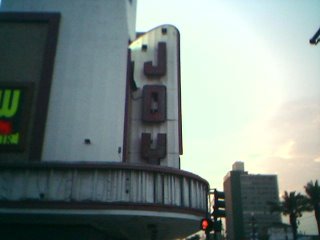Elks Place (Where Are We Now 1)
I set out Wednesday evening with my brain set on record. My goal was simply to report objectively on the state of affairs around the corner of Tulane Ave. and Elks Place. I imagined a grim task, but as always, N.O. managed a surprise.
I started taking notes at Armstrong Park, and my route would take me down Basin St., past St. Louis Cemetery #1, past the Iberville projects (one of the first public housing developments to reopen post-K), across Canal St., and into the medical center "corridor" of the Central Business District. This was a walk through what was once Storyville, "back of town," the infamous redlight district where jazz spent much of its infancy. As tourists who take this path often find to their disappointment, there is hardly a remnant of the Storyville period remaining. After dark, the cemetery is unsafe (every guidebook warns of this now), and unless you have an interest in the fate of public housing in New Orleans, there isn't much to draw you here. And I should probably admit that I had second thoughts about walking this route as I saw the sun getting lower in the sky. I quickened my step a bit as I rounded the corner at Armstrong Park, but a little boy dancing on the sidewalk stopped me cold.
He was holding a shoebox and dancing his own interpretation of the "Cabbage Patch": his hip jutting out to one side for a bit, he'd shake it and swing his butt back to the other side. And he was singing a song: "I got new shoes. I got new shoes." I don't think he could've been more than three years old. He held the box up for my inspection, and I nodded appreciatively at the white sneakers inside. "They give out shoes here," he said. "These are gonna make me jump high, high!" And he pantomimed jumping without leaving the ground. His younger sister had her own shoebox, containing a pair of pink and violet flowered sneakers. But she was absorbed by staring at the playground equipment inside the fence. They were standing behind Covenant House, a center for homeless youth and, apparently, a distribution point of clothing for kids who need it. I asked new-shoe boy his name and if I could take his picture with my camera phone. Edgar.
But she was absorbed by staring at the playground equipment inside the fence. They were standing behind Covenant House, a center for homeless youth and, apparently, a distribution point of clothing for kids who need it. I asked new-shoe boy his name and if I could take his picture with my camera phone. Edgar.
Already this wasn't the sort of reportage (it's French, bitch) I was expecting, but as I left Edgar and headed down Basin past the cemetery, I saw in the distance the flashing lights of at least four police cars, all parked outside the Iberville project. "Grim," I thought. But figuring my self-imposed task demanded that I get the story, I continued down the street. A block or so closer, and I could make out horses standing behind the sheriff's cars, cropping grass from the neutral ground. Another block, and I could see that the men on horseback were wearing fezzes. Yes, fezzes.

I stood in the neutral ground staring at them for a bit, looking from the befezzed horsemen to the Iberville residents milling about in front of their apartment block. And then I looked down the street, past the sheriff's cars and realized that this was not the scene of some new and bizarre crime, but a parade lining up, waiting to head down Canal St. Clowns of various sizes wandered up and down Basin St., performing with puppets for the children who had gathered. In addition to the horses and cars bearing beauty queens, there were golf carts and dune buggies, and anyone without a clown wig seemed to be wearing a fez. And everyone in the parade, in fact everyone on the street, was black. A black Shriner's parade--I couldn't quite wrap my brain around it. I mean, I'd never heard of black Masons before, but here they were, black Shriners in full regalia. And they were from around the country: New Jersey black Shriners and Washington, D.C. black Shriners. Their home cities were enblazoned on the backs of their shirts, along with the requisite Mason signs and symbols.

I finally asked one of the clowns, and he confirmed that it was the annual Shriner's convention for Ancient Egyptian Arabic Order Nobles of the Mystic Shrine. Last year, apparently, 8,000 of them had come down. This year, only 4,000. "You know," he said, behind his giant glasses, "it's a little smaller this year. Some people didn't come back." I told him I understood how that felt and welcomed them to town. I shook his gloved hand and headed up Basin St.
Can anyone still wonder why I love this place?

I worked my way through the Shriner's parade and up to Elks place, looking for the corner at Tulane Ave. Signs of rebirth: Walgreen's drugstore had reopened. On the other hand, several businesses remained closed. A pile of trash remained outside the darkened Smoothie King and PJ's Coffee. Plywood shuttered the buildings across the way.

At the focal point of my journey, on the corner of Elks and Tulane, is the main branch of the public library. Ah, but this post is long enough. I'll tell about the library in part 2.
I started taking notes at Armstrong Park, and my route would take me down Basin St., past St. Louis Cemetery #1, past the Iberville projects (one of the first public housing developments to reopen post-K), across Canal St., and into the medical center "corridor" of the Central Business District. This was a walk through what was once Storyville, "back of town," the infamous redlight district where jazz spent much of its infancy. As tourists who take this path often find to their disappointment, there is hardly a remnant of the Storyville period remaining. After dark, the cemetery is unsafe (every guidebook warns of this now), and unless you have an interest in the fate of public housing in New Orleans, there isn't much to draw you here. And I should probably admit that I had second thoughts about walking this route as I saw the sun getting lower in the sky. I quickened my step a bit as I rounded the corner at Armstrong Park, but a little boy dancing on the sidewalk stopped me cold.
He was holding a shoebox and dancing his own interpretation of the "Cabbage Patch": his hip jutting out to one side for a bit, he'd shake it and swing his butt back to the other side. And he was singing a song: "I got new shoes. I got new shoes." I don't think he could've been more than three years old. He held the box up for my inspection, and I nodded appreciatively at the white sneakers inside. "They give out shoes here," he said. "These are gonna make me jump high, high!" And he pantomimed jumping without leaving the ground. His younger sister had her own shoebox, containing a pair of pink and violet flowered sneakers.
 But she was absorbed by staring at the playground equipment inside the fence. They were standing behind Covenant House, a center for homeless youth and, apparently, a distribution point of clothing for kids who need it. I asked new-shoe boy his name and if I could take his picture with my camera phone. Edgar.
But she was absorbed by staring at the playground equipment inside the fence. They were standing behind Covenant House, a center for homeless youth and, apparently, a distribution point of clothing for kids who need it. I asked new-shoe boy his name and if I could take his picture with my camera phone. Edgar.Already this wasn't the sort of reportage (it's French, bitch) I was expecting, but as I left Edgar and headed down Basin past the cemetery, I saw in the distance the flashing lights of at least four police cars, all parked outside the Iberville project. "Grim," I thought. But figuring my self-imposed task demanded that I get the story, I continued down the street. A block or so closer, and I could make out horses standing behind the sheriff's cars, cropping grass from the neutral ground. Another block, and I could see that the men on horseback were wearing fezzes. Yes, fezzes.

I stood in the neutral ground staring at them for a bit, looking from the befezzed horsemen to the Iberville residents milling about in front of their apartment block. And then I looked down the street, past the sheriff's cars and realized that this was not the scene of some new and bizarre crime, but a parade lining up, waiting to head down Canal St. Clowns of various sizes wandered up and down Basin St., performing with puppets for the children who had gathered. In addition to the horses and cars bearing beauty queens, there were golf carts and dune buggies, and anyone without a clown wig seemed to be wearing a fez. And everyone in the parade, in fact everyone on the street, was black. A black Shriner's parade--I couldn't quite wrap my brain around it. I mean, I'd never heard of black Masons before, but here they were, black Shriners in full regalia. And they were from around the country: New Jersey black Shriners and Washington, D.C. black Shriners. Their home cities were enblazoned on the backs of their shirts, along with the requisite Mason signs and symbols.

I finally asked one of the clowns, and he confirmed that it was the annual Shriner's convention for Ancient Egyptian Arabic Order Nobles of the Mystic Shrine. Last year, apparently, 8,000 of them had come down. This year, only 4,000. "You know," he said, behind his giant glasses, "it's a little smaller this year. Some people didn't come back." I told him I understood how that felt and welcomed them to town. I shook his gloved hand and headed up Basin St.
Can anyone still wonder why I love this place?

I worked my way through the Shriner's parade and up to Elks place, looking for the corner at Tulane Ave. Signs of rebirth: Walgreen's drugstore had reopened. On the other hand, several businesses remained closed. A pile of trash remained outside the darkened Smoothie King and PJ's Coffee. Plywood shuttered the buildings across the way.

At the focal point of my journey, on the corner of Elks and Tulane, is the main branch of the public library. Ah, but this post is long enough. I'll tell about the library in part 2.

0 Comments:
Post a Comment
<< Home